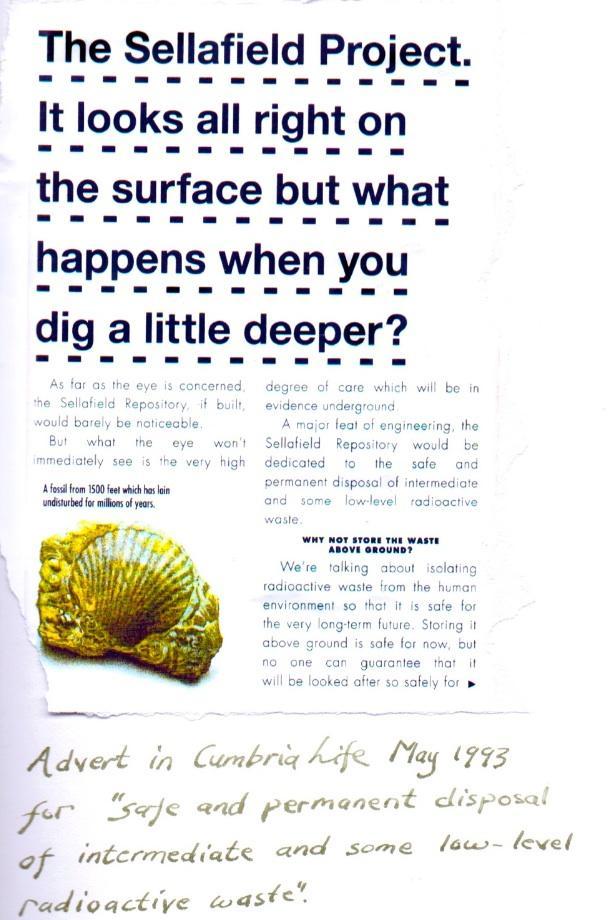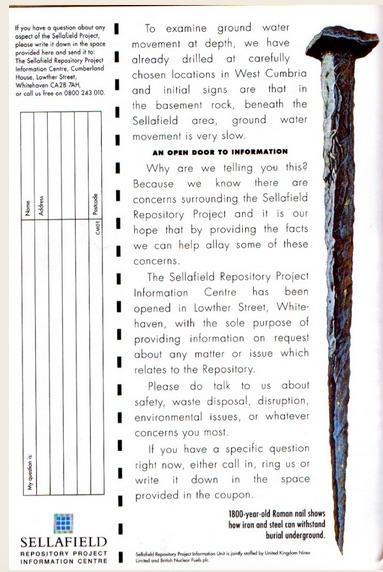
3 minute read
Low Level Waste Repository - a History page 2
from Nuclear Waste's Shifting Sands on the Lakeland Fringe
by Lakes Against Nuclear Dump - a Radiation Free Lakeland campaign
"The Drigg site uses two disposal systems:
1) An original system operated from 1959 (?) to 1988 comprising a series of parallel trenches excavated into glacial clays, back filled with LLW and covered with an interim water resistant cap. 2) Current disposal of compacted waste placed in steel ISO-freight containers, with void space filled with highly fluid cement based grout. These containers are then disposed of in a series of open concrete vaults.
Advertisement
"Radionuclides with highest activities in the inventory include 3H, 241Pu, 137Cs, 234U and 90Sr, 238U and 232Th.
DANGEROUS COCKTAIL “LOW LEVEL”
NUCLEAR WASTES
There is already at the LLWR a cocktail of relatively short-lived, intensely radioactive species such as tritium, caesium, strontium and plutonium with half lives measured in years and decades, with daughters such as americium 241, dangerous for centuries, mixed in with uranium and thorium isotopes with half lives as long as 14 billion years. 'Low level waste is not low hazard' Professor Claire Corkhill speaking on BBC Radio 4 Inside Science
The Drigg site is approximately 300m from the sea and lies about 8m above mean sea level and is “likely to be destroyed by coastal erosion in 500 to 5,000 years” (BNFL Post Closure Safety Case). This conclusion is accepted by the Environment Agency. This assessment was derived from projections developed by the UN Intergovernmental Panel on Climate Change (IPCC, 2001) using computer models on future sea level rises driven by climate change. (ref Greenpeace Comments on Environment Agency’s Assessment Documents on Drigg 2005)
For all the above reasons Radiation Free Lakeland have called for the gates to be locked on Drigg and for “low level” nuclear waste dumping adjacent to the Drigg dunes to cease.
However far from stopping nuclear waste “disposal” at Drigg the industry is looking for novel ways to divest nuclear wastes arising from the decommissioning of redundant nuclear plants. This has included diverting nuclear wastes from Drigg to landfill, incineration and radioactive metal recycling. "The diversion of waste from disposal at the LLWR has resulted in significant life extension and avoided the need to develop a replacement LLWR” .
This, in the perverse logic of the nuclear industry,
“frees up” Drigg for a “vision” to dispose of ever higher activity nuclear wastes. The Nuclear Decommissioning Authority say that their
“strategic preference is to develop Near Surface Disposal” (for Intermediate level nuclear wastes) and that they "will support government policy development in that area. ” In other words Near Surface Disposal of Intermediate Level Wastes is currently not government policy.
MISSION CREEP
The following images are from a four page Advertorial by NIREX in Cumbria Life from 1993 (NIREX was the then government body equivalent to Radioactive Waste Management under the newly formed Nuclear Waste Services ) The NIREX plan was for "deep disposal” of intermediate and some low level nuclear wastes in a Geological Disposal Facility. Now in 2022 the "vision" is to dump intermediate level nuclear wastes into Near Surface Disposal (10s rather than 100s of metres below ground) at the Low Level Waste Repository at Drigg. The higher activity and very hot nuclear wastes which NIREX never proposed putting deep underground would be dumped into a Geological Disposal Facility.


The NIREX advert from 1993 states that the Geological Disposal Facility plan is for "intermediate and some low level wastes. ” In a mission creep operation the new vision is to divert intermediate Level Wastes to Near Surface Disposal thus freeing more space in a GDF for High Level Wastes.
“On the Level” March 2021 Newsletter for the Low Level Waste Repository says: “The NDA is exploring the benefits of developing Near Surface (NSD) – for disposing of a proportion of Intermediate Level Waste (ILW), but no decision has been taken on whether UK Government will pursue this option or whether LLWR, will in time, host a NSD facility.





